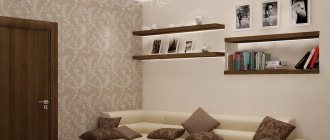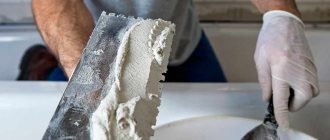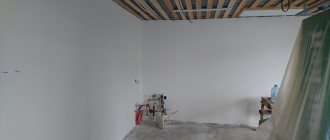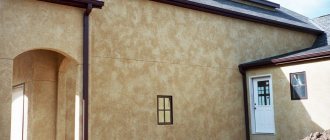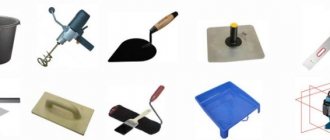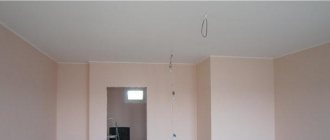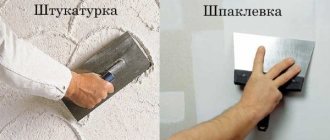Machine plastering or hand plastering – which is better? Puzzled by this question, a beginner rushes to find the answer on construction forums, where he encounters conflicting advice. As a result, the question remains unsolved, but the problem needs to be solved.
Not only the cost, but also the duration of the repair process and other parameters depend on which method to choose. Let's take a closer look at both options from different angles. Go!
Which plaster is better: manual or mechanized?
First, let’s clarify what we mean by the expression “machine method.” We do not consider applying the solution using the simplest devices, such as a hopper or just a cartouche gun.
We will compare the manual method (preparing the mixture and applying it to the base is done by hand) and plastering, in which the solution is prepared and supplied to the wall using a plastering machine.
The methods have some overlaps, as well as a number of differences; we will consider the latter when choosing which is better.
We analyze the existing differences according to several criteria.
- When plastering the facades of one-story buildings manually, scaffolding or scaffolding is needed, which are not required for mechanized plastering if the surface of the “coat” is not smoothed.
- Inspection of the condition of the wall, old covering and other preparatory operations are no different.
- Beacons for manual processing can be installed in increments of 1.2-1.5 m. For machine application of the solution, the beacon spacing is no more than 1 m.
- The cost of dry plaster mixtures (SS) for machines is less.
- The productivity of mechanical application is 3 times higher (minimum).
- The consumption of plastering materials during manual labor is higher.
- The quality of the coating after mechanical plastering is higher due to the achievement of a homogeneous consistency, uniform application, and pressing of the solution by the force of the spray.
- Need for equipment. When plastering by hand, you need the usual plasterer's tools. For mechanized application, a machine station (or plastering machine), a compressor, a feeding gun, and hoses are required.
- Labor intensity is higher for manual application.
- Work upon completion of application of the solution.
- Level of required professionalism. Mechanical plastering requires mandatory training and special training.
As you can see, when deciding whether mechanized or manual plastering of walls is preferable, there is a lot to consider.
Surface preparation
Plastering surfaces on any object begins with their preparation. Mechanized plastering of the facade requires preliminary cleaning of the surface. All sorts of irregularities protruding more than 10 cm, caused by the influx of building materials present on it, are removed from it. They also get rid of protruding metal elements, they are protected from corrosion.
Dust is removed from uneven substrates using pressure spray guns. A reinforcing mesh with cells measuring 5x5 or 10x10 mm is applied to cracks and places where different materials join.
Then a check is made of the verticality of the surface with a long plaster level (2-3 m) and horizontality (using a template, a cord) to determine the most protruding areas. Using corner templates (rules), corners are checked and guide beacons are installed according to markings.
Working with a plastering machine
Before starting work, the equipment is connected to the electrical network and water supply system. It should be used when the ambient temperature is above zero in the range of 5° C - 30° C.
Plastering walls using a mechanized method follows one principle. A dry mixture with water is placed in the mechanism’s hopper, which can be of different volumes (from 30 to 75 kg), here the composition is loosened and it is saturated with oxygen.
Water can be pumped into the bunker from any container using a pump (included with the device).
The required parameters of the finished solution are set, for which the required ratio of components is programmed in the device. A mortar hose is used to supply the plaster to the work site. Here it is evenly thrown onto the prepared surface using special nozzles. Then it is leveled with wide spatulas. When performing work, an air gun can also be used.
The step-by-step work in which a machine is used to apply plaster occurs as follows:
- the surface is prepared (cleaning from dirt, deposits, remnants of old coatings, dust, measuring curvature, installing beacons, strengthening corners, treating metal surface elements with an anti-corrosion agent);
- the mixture is prepared using a plastering machine (the dry mixture is mixed with water until a homogeneous consistency);
- the finished composition is mechanically applied to the surface in a layer 3-20 mm thick;
- leveling, removal of excess, finishing of difficult places (corners, niches, joints) to condition is carried out;
- the surfaces are rubbed with a special sponge after 2 hours to give the surface smoothness;
- The levelness of the finished coating is checked using a building level.
On day 4-5, the dried surface is ready for finishing.
Mechanized wall plaster pros and cons
Let's take a quick look at how the process of machine plastering proceeds.
- As stated above, preliminary preparation, as well as priming of the base, are performed in the same way as similar steps when applying the composition manually.
- They prepare the “machinery” for the work (connect the machine, hoses, compressor, water, set up the equipment).
- The SS is poured into the receiving bunker. The machine, mixing water with the mixture, begins to produce a mortar mass.
- The plasterer, holding the spray head, applies the mortar in rows to the wall. The operator serves the station.
- The laid mortar is leveled according to the rule (for interior work).
- Upon completion of application of the mixture, the “machinery” is cleaned, disassembled, and dried.
- The beacons are removed by manually sealing the grooves.
The first difference is the plaster mixtures used, since for machines where the solution is prepared automatically by the working parts of the station, the uniformity of the granulometric composition of the components is important. The manufacturer also introduces additives into the dry mixture that reduce the adhesion of the solution to the internal surfaces of the supply paths of the plaster material.
Builders can also use mixtures not intended for mechanical plastering, but must take all measures to prevent the ingress of large fractions of filler or binder, as well as low-quality components.
The list of advantages of mechanized plaster is impressive:
- Since the preparation of the working mixture is carried out in a machine, dust formation in the room is minimal.
- SS for machine plastering is cheaper, so money is saved when purchasing factory-made compounds.
- The solution consumption is several times less than with manual plastering. Again - savings.
- The mass thrown under pressure lies more densely and adheres more tenaciously to the base.
- When applied, due to the entrained air, a coating is formed that is “saturated” with pores, through which the walls breathe better, and the desired microclimate is maintained in the room.
- By increasing porosity, the coating's ability to retain heat increases.
- The likelihood of shrinkage of the applied layer is reduced, which reduces the possibility of cracking and chipping.
- Dense application increases the strength of the coating (when screwing in the screws, the material does not crumble).
- After leveling, the layer does not require puttying (applies only to gypsum compositions).
- The quality of the plaster “dough” prepared by the machine’s augers is higher. The machine stores in memory information about the proportions of different compositions. The operator just needs to select a mode.
- A small number of employees (but not less than two, and more often three people).
- Low cost of work. Please note (we are not talking about price).
- Machine-laid coating lasts longer.
Disadvantages of machine plaster:
- To carry out the work, expensive equipment is used and a team of specialists is required.
- Some plastering machines require a three-phase connection, which is not available at every facility.
- Energy consumption is increased.
- If splashed indoors, severe contamination may occur.
- The period of possible work completion has been narrowed due to the noise produced by the mechanisms. Plastering cannot be done at night or in the evening.
- The machine and compressor require maintenance immediately before and after plastering. It is also necessary to wash and dry the equipment after finishing work.
- The method is not suitable for plastering curved surfaces (for example, columns).
- Special corners are needed for machine plastering of internal corners.
- The peculiarities of applying the solution lead to the creation of a coating that requires long-term drying. Finishing of the walls is possible only a week after the completion of plastering.
- Also, the characteristics of the created layer affect the possibility of tiling. The tiles do not hold up well and will peel off over time.
- With cement mixtures, machine performance decreases.
- A lot of space is required to accommodate the compressor, CMM and hoses, which is lacking in small rooms.
Manual plastering advantages and disadvantages
You can get acquainted with the technology of plastering in detail in the articles in the “Plastering” section.
Let's take a quick look at the sequence:
- Preparing the base.
- Preparing the mixture (using a mixer or mortar mixer).
- Installation of beacons.
- Applying the solution (from 1 to 3 passes).
- Grout.
- Excavation of lighthouse profiles, sealing of grooves.
- Puttying.
- Drying before finishing.
List of advantages:
- Even a beginner, with practice, can apply plaster mortar manually to the base using ordinary plastering tools.
- No expensive equipment needed.
- Possibility of stage-by-stage repairs (when not the whole house needs updating, but individual rooms).
- You can work at any time convenient for the owner, including at night.
- Possibility of plastering and careful processing of hard-to-reach areas and curved surfaces.
- Possibility of direct control and adjustment during each operation.
- There are fewer difficulties with selecting components for the mixture (the composition is selected independently).
- Easier to find performers.
- Since the solutions are prepared in small batches, it is easier to switch from gypsum compositions to cement ones (for example, for plastering a bathroom after a kitchen or living room).
Minuses:
- Manual labor is more labor intensive than mechanized labor. Great physical activity. When plastering large areas, more workers will be required to speed up the work.
- It requires the preparation of three types of compositions (spray, base - primer, covering).
- High consumption of plastering materials.
- Low productivity.
Advantages of machine application
The price for machine applied plaster work depends on the amount of work that needs to be done. Thus, the work of a team of 3-5 people with a volume of up to 150 sq. m. will be 350 rubles per square meter.
Before you get started, you need to prepare an auxiliary tool:
- Spatula, trowel;
- Rule;
- Beacons;
- Reinforcing elements;
- Grater, ironer.
Machine plastering is performed using a certain technology. So, the main stages of work are as follows:
- Let's prepare the surface for applying the plaster mixture.
- We install beacons and attach reinforcing corners to the corners.
- We set up equipment.
- We prepare the mixture by machine.
- Apply plaster to the surface.
- Align the planes.
- We perform puttying.
What is machine plaster?
Preparing the surface for plastering involves cleaning it from remnants of old mortar, various contaminants, greasy stains, etc. If there are any metal parts, they need to be cleaned and coated with an anti-corrosion agent. Next we prime the surface.
After this, we strengthen the corners with special reinforcing corners. We also do reinforcement of problem areas such as joints and seams of drywall, concrete slabs, etc. Next, using a long level, we will check the planes for verticality and horizontality. Corner patterns or rules will help determine how even the corners in a room are. After this, we mark the installation locations of the beacons and secure them with mortar or fasteners.
Setting up equipment for plastering involves the delivery and installation of equipment on site. To operate, you need a source of electrical power and water supply. In the absence of the latter, the plastering machine can operate thanks to a pump that will take water from any container.
What is better to choose and in what case
To facilitate the choice between machine or manual plaster, a table will help, in which each plus or minus is considered.
| Comparable criteria | Plastering method | |
| mechanical | manual | |
| Solution quality | Higher, more even consistency | Depends on skill, generally inferior |
| Mixture consumption | More economical | Depends on skill |
| Compositions used | Special factory-produced mixtures based on gypsum or cement | Purchased SS are on the same basis, however, the choice is wider. You can prepare the solution by selecting the components yourself |
| Restrictions | Due to noise, cannot be used during quiet hours | any |
| Unsuitable for curved surfaces, hard-to-reach areas | No restrictions | |
| The lack of a three-phase power supply narrows the choice of equipment brands | No restrictions | |
| Not applicable at sub-zero temperatures | In case of sub-zero temperatures, winter plaster is used | |
| Requires special training and experience | Can be performed by beginners after a little training | |
| It is impossible to place equipment in small rooms | No restrictions | |
| Problems with using under tiles | No restrictions | |
| Plastering time | Application is faster, drying takes longer | For small areas, the master is able to process the surface at almost the same speed. Loss with large surface areas. |
| Work productivity | higher | below |
| Coating quality | Overall higher | Depends on skill, generally lower |
| Application | Universal (for interiors and facades) | universal |
Choosing a mixture
When choosing a mixture for machine application of plaster, you should pay attention to what kind of work it is intended for - interior or exterior. Manufacturers usually indicate this information on the packaging. There must also be information that the solution is suitable for machine application.
The composition of the mixture depends on the requirements of the room in which the work will be carried out. Typically, gypsum and cement based compositions are used for plastering walls.
Tip: When choosing a mixture, experts recommend using putty, primer and plaster from the same manufacturer! This ensures good interaction and adhesion of the compounds, which guarantees a long service life of the coating.
Cement-based compositions are the most popular. They are used for finishing surfaces both indoors and outdoors. Cement mixtures are particularly durable and resistant to frost, moisture and other environmental factors. The disadvantage of this type of coating is that they are prone to cracking over time. Usually sand is added to the cement mortar. And for rooms with high humidity, such as a basement, garage, cellar, lime is also added.
Gypsum-based mixtures are also widely used. They are quite durable and resistant to mechanical stress. At the same time, they are highly breathable and environmentally friendly. An important factor in application is their instability to moisture. Therefore, gypsum plasters are used only indoors, and, moreover, only in rooms with normal humidity. This type of plaster is not used for the kitchen, bathroom, or swimming pool.
Advantages of machine plaster
Using an automatic plastering machine, the solution is prepared automatically in a special container of the device. This point is also a huge plus and eliminates the need to knead the mixture by hand. In addition to the above advantages, the mixtures also have the following properties:
- Good adhesion to the treated surface;
- Excellent heat and sound insulation;
- Dries quickly;
- They gain strength in a short time.
Dry plaster mixtures of the Knauf, Bergauf, Starateli, Ceresit, Volma, Gippsel brands have proven themselves well.
Thus, gypsum plaster MP-75 from TM Knauf has established itself as a high-quality mixture. In addition to gypsum, it contains various polymer additives that give it viscosity for good adhesion to the surface. This mixture is used both for treating walls and ceilings.
Can machine plaster be applied by hand?
Since machine plastering of walls is carried out with special mixtures, which are sometimes 30% cheaper, this quite reasonable question arises.
Such mixtures can be used for manual application, but problems may arise:
- When selecting proportions, it is difficult to immediately correctly determine the volume of added water (manufacturers do not indicate this, since the parameters are included in the CMM). In order to find out the correct proportions, you will first need to draw the SS by eye. Such an experiment takes time and increases material consumption.
- For an experienced plasterer, when switching to a machine mixture, the setting and drying time of the composition and its plasticity will be unusual. You will have to “relearn”, which also lengthens the process.
- Fake mixtures have appeared on the shelves, the quality of which has not been verified. This problem especially concerns brand names.
- Do not buy into the opportunity to save money by purchasing expired formulas. The wall may look good at first after plastering. And all the troubles will appear over time.
As you can see, you have to decide for yourself: machine plastering or hand plastering, which is better? – the task is multifaceted. In each specific case, the answer may be different. If you cannot make a choice on your own, contact trustworthy specialists.
Areas of use of the mechanized plastering method
The method under consideration is used in work carried out on large surface areas of premises. It should be remembered that the surface of the wall must be flat, without figured structures. Such buildings do not include large niches or openings, however, elements in the form of half-columns, arches and other complex parts will prevent the wall from being evenly covered with plaster using the apparatus.
This is the only limitation for the machine.
The composition for the mixture is selected depending on the plastering location, namely, cement compositions are used mainly for facade finishing, and gypsum-containing mixtures are used for interior finishing.
In both cases, the device does an excellent job of applying and mixing the solution.
